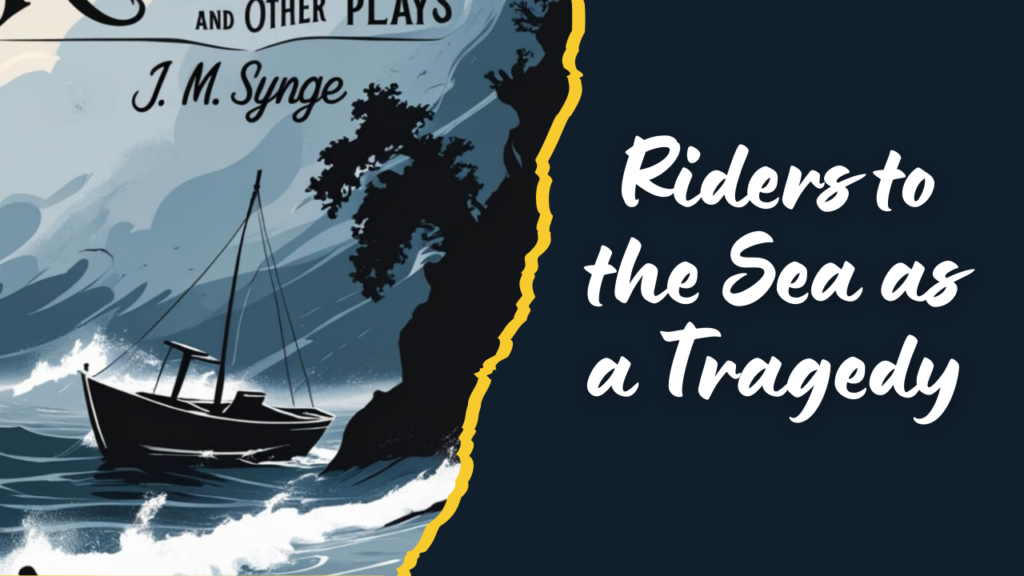Introduction
William Butler Yeats commented that Edmund John Millington Synge’s Riders to the Sea (1903) is
“written out of a deep knowledge of the life of the people… He has gone every summer for some years past to the Aran Islands and live there in the house of the fishers, speaking their language and living their lives. This enthralling Irish literary piece… I would acclaim as one of the greatest dramatic literature… one-act play… The play deals with a battle of survival against an unmatched opponent, the sea, which exercises an enormous power over the lives of Aran people… This one act play in the words of Yeats was, “the finest piece of tragic work done in Ireland of late years.”
Plot of Riders to the Sea
As the Greek philosopher, Aristotle stated that plot “is the soul of a tragedy”, the plot in Riders to the Sea is simple, the action is concentrated, and the impression is consistent. It does not involve any deviation from the main theme. The play opens in the cottage, kitchen where Nora and Cathleen provides oblique references to Maurya, their anxiousness to search the bundle of clothes to specify whether it belongs to their missing brother Michael.
Maurya’s futile attempt to persuade Bartley from embarking on any sail to Connemara. Maurya’s vision of Bartley’s death and elevation of Maurya to a universal tragic figure. There is brevity in the plot and it remains concentrated and consistent till the end of the play. It dominantly focuses on ineffectual attempts. In an one-act play, the plot is precise and concerned with only a single main incident of the play. Here, in this play, the dominant theme is the continuous battle with the sea for survival and how Maurya loses all her sons to the sea.
Beginning, Middle and End
A play should have a beginning, middle and end. According to Aristotle, “a whole is what has a beginning, middle and end.” Riders to the Sea is basically concerned with its end, keeping the other two secondary. an implied position. The powerful presentation, concentration and suggestiveness makes the whole play come alive. It does not require to have an exposition or an in-depth character description.
The play begins immediately with the predominant subject matter. It becomes successful in arresting the attention of the audience. Nora and Cathleen’s conversation with the oblique references to the protagonist Maurya; the mystery around the bundle of clothes; the threatening presence of the sea; the gust of wind with which the door opens, imply that something unfavourable is going to happen.
Stage Direction
One-act plays are also popular for the concept of stage direction. Synge has provided a remarkable and symbolic stage direction. “scene: an island of the west of Ireland cottage kitchen with nets, oilskins, spinning wheel, some new boards standing by the wall, etc.”
It is the cottage kitchen where the whole play is set. The other incidents that happened in the play are conveyed through exchange of words. At the same time, it is very important that new boards are also present in the kitchen. It indirectly refers to the coffins that will be made for the dead person.
Unity of time, place and action
Structurally, this one-act play remains faithful to time, place and action. “It is very much Aristotelian in structure.” The play never shifts from the kitchen cottage. No information is given about the other places in other rooms. Maurya’s vision and Bartley’s death are revealed through speeches. The time-span of the play is also short, that of 10 minutes to about an hour. Riders to the Sea observes both unity of place and time.
The most important unity of action is articulated meticulously. The play opens when the fifth son of the family, Michael, is missing and Bartley is the last one. Bartley is preparing to go to Connemara for the subsistence of his family. Bartley meets his death and Maurya is at once free forever from her inner conflicts and anxieties. “In the words of Maurya, “They are all gone now, and there isn’t anything more the sea can do to me.” No necessary details are present. In an one-act play, a question is posed at the beginning, to which the solution is provided at the end for the eagerly awaiting riddles and audience. Maurya’s old, Michael is missing and would Bartley go of or save from going to the sea. Bartley meets his death and Maurya becomes destitute of all her sons.
Conclusion
Generally in one-act plays the number of characters is minimal. In Riders to the Sea, the important characters are Maurya, the protagonist, Bartley, her son; Nora and Cathleen, the chorus characters and men and women of the island. Maurya is the tragic protagonist of the play and it deals with the anxiety, suffering, tragedy and pangs of separation of a peasant woman belonging to a fishermen community.


